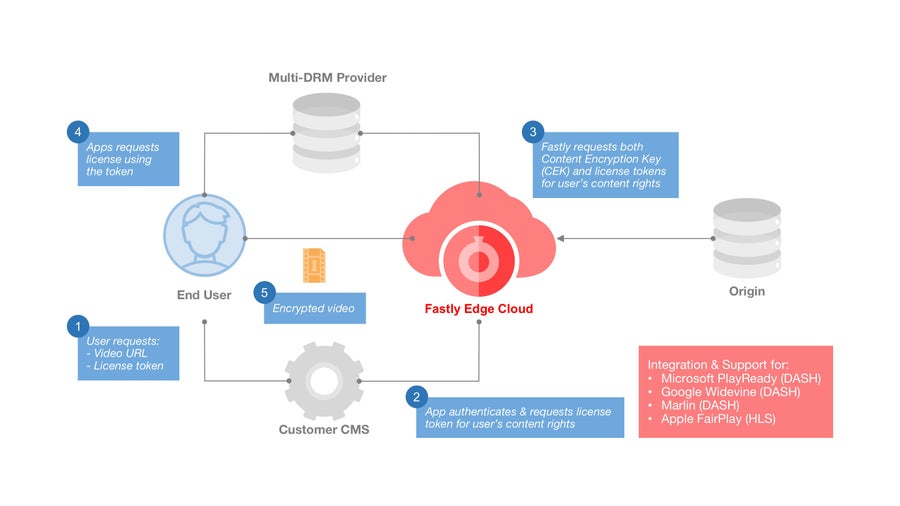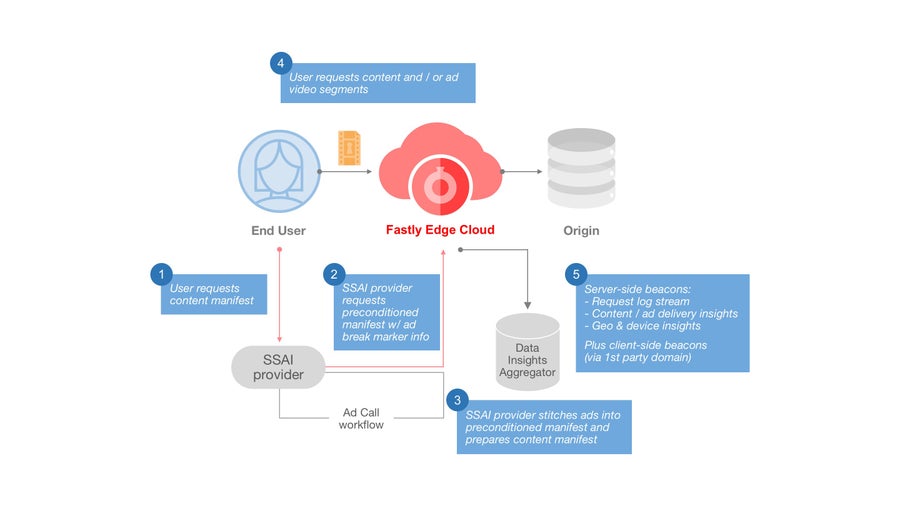Multi-DRM & Content Preconditioning for OTT Providers | Fastly

Senior Product Manager, Fastly

Director of Product Marketing
Last year we released On-the-Fly packaging (OTFP) support for MPEG-DASH Common Encryption (CENC), enhancing our transmuxing service to help you protect your video content. In an ongoing effort to help you provide the best streaming experiences for your end users, we’re excited to announce two new features to our OTFP service: multi-DRM support and content preconditioning enable over the top (OTT) video service providers to protect and efficiently monetize premium video content.
Multi-DRM support allows you to protect content by automatically encrypting and supporting digital rights management (DRM) for your content library packaged by our OTFP. Content preconditioning helps you efficiently monetize content by quickly preparing manifest files for ad insertion. By eliminating bottlenecks in your ad insertion workflows, your team can release content as soon as a transcoded profile is available, putting you in the best position to capture views and ad revenue.
In this post, we’ll take a closer look at the OTT market and how these new features will help content owners and advertisers address some of the challenges with OTT workflows.
OTT: a brief overview
Over-the-top (OTT) content, or content that is delivered over the internet instead of traditional methods involving cable and satellite broadcasters, is completely changing the way we consume audio and video: 81.2% of US internet users (over 221 million viewers) are forecasted to watch video online at least once a month in 2017,1 and most 13-24 year olds already spend more time with ad-supported and subscription digital video services than with traditional TV.2
The OTT market is forecasted to reach $64.9 billion by 2021,3 and with growth comes new technical challenges: How do you better protect and monetize your content while gaining more meaningful insights for analysis?
Protect with multi-DRM
Our integration with multi-DRM service provider ExpressPlay allows you to dynamically add DRM to video on-demand (VOD) files that are packaged by our OTFP service. We enable content protection across the most popular platforms and devices being used today, including Apple FairPlay, Google Widevine, Microsoft PlayReady, and Marlin. In addition, moving these traditionally offline DRM workflows to the edge of our network helps streamline internal processes and reduce operational and infrastructure costs, allowing you to use popular players like Shaka, DASH.js, or other native HLS players with no proprietary SDK / library integration to enforce rights management.
In the diagram below, you can see how Fastly interacts with the content management system (CMS) and the multi-DRM provider to deliver a DRM-protected content to the end user.

Fastly's multi-DRM support
DRM service providers generate and deliver licenses a few different ways; for our integration with ExpressPlay, Fastly acts as a proxy for generating the tokenized DRM license URL from the content rights associated with the requesting end user. The player then requests the DRM license using this tokenized URL and allows the end user to access the content.
We support any DRM service provider’s workflows, and will continue to add support for more DRM providers over time.
Multi-DRM support builds on and extends our existing content protection functionality. Depending on the level of protection you need, Fastly’s edge cloud platform provides several different ways to secure your video content. Together, these methods provide greater flexibility and control over how you protect different titles in your library:
End-to-end TLS delivery & encryption. Terminate connections at the edge for improved performance.
Edge authorization tokens. Validate in-flight requests before content is served to your viewers.
Geographic blocking. Automatically detect the region (city, state, country, or continent) your viewer is coming from and prevent unauthorized access at the edge.
Media encryption. Secure HLS and MPEG-DASH videos at rest by generating a unique content encryption key (CEK) for each video. We support AES-128 and SAMPLE-AES for HLS and MPEG-CENC with ClearKey for MPEG-DASH.
Monetize with content preconditioning
Several different OTT monetization models have emerged over the past few years, and while we won’t go over them in detail here, there are plenty of excellent articles explaining the different models around the web. Fastly enhances existing ad workflows and helps facilitate ad integrations for one of the common models being used today, ad-supported VOD (AVOD).
You can integrate ads by leveraging a server-side solution like Google DFP or by using one of the many client-side solution providers like Freewheel, Tremor Video, or SpotX. No matter which approach you take, a common challenge is preparing the manifest in a way that makes it easy to stitch advertisements. When an ad needs to be inserted in a video, the manifest needs to be updated to:
Segment the video at ad breaks during packaging.
Add vendor-specific metadata that triggers dynamic ad insertion (DAI) workflows.
The manifest update process — especially if it’s manual — can take time, and any delay in posting video could result in lost views and ad revenue. With our new content preconditioning feature, you can automatically prep the manifest file for ad insertion during packaging and cache the manifest at the edge. This automation helps you kick off your workflows sooner, get content to market faster and capture more ad revenue. And since we’ve built content preconditioning to be vendor-agnostic, you can integrate Fastly with any DAI vendor you choose.
In the diagram below, you’ll see how Fastly preconditions the manifest and prepares it for ad insertion.

Fastly's content preconditioning
Additionally, Fastly offers timed metadata injection for HLS, letting you embed custom metadata or ad markers in a video timeline to signal a player to take action, like play an ad or send playback beacons.
Analyze with video delivery insights
Understanding how your audience responds to your video strategy is critical to measuring success, so it’s important to be able to analyze the effect of protection and monetization on viewer engagement.
Fastly provides server-side visibility into viewer engagement metrics. Our video delivery insights surface metrics — like which resolutions or formats are being requested and how they impact engagement — by streaming real-time logs and exposing additional log fields that you can analyze in your preferred log aggregation service. When coupled with client-side engagement metrics, you get a complete view into the effectiveness of your ad insertion strategy.
We hope these new video features will help you build and enhance your existing OTT workflows. Contact sales@fastly.com to try them out for yourself — we’d love to hear what you think!
Sources:
US Digital Video Viewers and Penetration, 2017-2021, eMarketer, February 2017
Acumen Report: Youth Video Diet, Defy Media, 2016
Global Over The Top (OTT) Market Forecast and Opportunities 2011-2021, Research and Markets, 2016